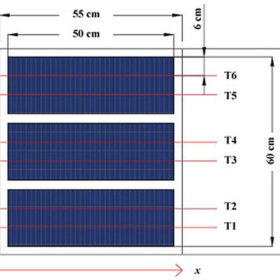ACWA Power reaches financial close for 200 MW solar project in Egypt
With an overall investment cost of US$182 million, the Kom Ombo plant is expected to be commercially operational in January 2024.
Novel fins increase floating PV productivity, reduce LCOE by over 17%
A group of researchers in Egypt studied the use of partially submerged angle perforating fins (PSAPF) and solid fins (PSASF) to assess their ability to remove excess heat from floating photovoltaics under Mediterranean outdoor environments. The team found that the optimized PSAPF-FPV module achieved an LCOE of $0.068/kWh).
Technology brings universal access to clean energy within sight
The opportunities available from the aggregation and interpretation of mass data are huge and could help attract investors and ensure more efficient electricity networks as the world races to try and achieve the UN goal of access to reliable energy for all this decade.
Inverted perovskite PV cell with silver thiocyanate HTL hits 16.66% efficiency
Egyptian researchers have developed a novel hole transport layer (HTL) for inverted perovskite solar cells using silver thiocyanate instead of the commonly used PEDOT:PSS and copper thiocyanate. The new HTL material demonstrated exceptional efficiency and stability in the constructed cell.
Integration of EV charging stations and renewable energy resources
A new research paper proposes an optimal planning technique to identify the locations and sizes of electric-vehicle (EV) charging stations with controlled charging and hybrid wind and PV systems in a multi-microgrid.
Only5mins! – ‘Additionality’ must be adhered to in Africa’s green hydrogen development
Chigozie Nweke-Eze is an economist, geographer and founder of Integrated Africa Power. He sat down with pv magazine to discuss green hydrogen development in Africa, from the project pipeline to the necessity of “additionality” when it comes to ensuring hydrogen doesn’t become yet another exploited African resource.
Passive solar module cooling tech based on paraffin wax
Egyptian researchers have used paraffin wax as a phase-change material (PCM) to reduce the operating temperatures of PV modules. They have found that the material improves power yield by more than 15%, compared to a reference module without cooling.
Africa closing in on gigawatt-level solar
Solar installations across Africa hit 949 MW in 2022, bringing cumulative capacity past the 10 GW mark, according to the African Solar Industry Association (AFSIA). While that may seem underwhelming for such a huge region, it shows that countries are taking big steps toward realizing the entire continent’s PV potential.
Hydrophobic nanocoating to reduce soiling in solar panels
Scientists in Egypt have created a self-cleaning, hydrophobic coating for solar panels that reportedly increases their efficiency by more than 30%. They used a coating solution based on polydimethylsiloxane (PDMS) and silicon dioxide (SiO2) nanocomposites, mixed with ethanol and isopropanol.
COP27 was a crucial step forward for hydrogen – here’s why
Three import deals signed by the EU at Sharm El Sheikh during this month’s COP27 summit show the European Union is serious about harnessing green hydrogen for its heavy industry, and about distributing the fruits of the energy transition on an equitable basis.










